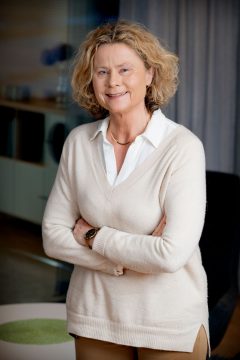
COLUMN. At all levels within the faculty, a great deal of effort has gone into compiling the documentation for the external evaluation of research, RED19. Now it is important for us to act on the proposals presented by the external experts. Dean Agneta Holmäng addresses this in her column.
RED19, the acronym for Research Evaluation for Development 2019, has now presented its report in which the faculty as a whole and our departments have provided several constructive proposals for how we can create the potential for even better research. We also receive a lot of praise, which gives us reason to be proud. Among other things, we have succeeded in recruiting young researchers and in giving them the support they need to establish independent research teams. When outstanding newly employed colleagues do well, it makes a good impression in education circles, which can lead additional young researchers and also more senior ones to find their way here.
Evaluations are important but should not happen too often
I think the RED19 evaluation was very good and rewarding. Having said this, I would also like to state that I am not entirely positive about this type of review. Evaluations are important but should not happen too often because they take so much time and energy that employees find it difficult to devote themselves to their main tasks. It has been about ten years since the last evaluation, RED10, so it is probably appropriate to have another evaluation now.
The evaluation does not really present any surprises
We are now in the middle of the process in which the faculty and our departments process and analyze the results of RED19. At the beginning of the semester, the report was discussed with Faculty Management at the joint start-up meeting for the Faculty Board and the department managements. We have now received templates from the central administration that the organization at all levels will use to review the results of RED19 and specify the measures that can be implemented in response to the critique. These action plans will be submitted in December and followed up during the discussions we will have with the departments this spring.
We can note that the evaluation does not really present any surprises. It points to problems we already know about, but it is still important for us to have them compiled, since we need to address these issues.
The main considerations should be the researcher’s international experience
The fact that we largely recruit our researchers and teachers internally is one such challenge. The mobility of academic personnel is generally low in Sweden. According to the latest research barometer from the Swedish Research Council, about 64 percent of the personnel at broadly established universities have a doctorate from the same university currently employing them. On the whole, mobility is lowest in the agricultural sciences, followed by the medical and health sciences, where 57 percent have a doctorate from their own university. The expert panel behind RED19 believes that we should try to fill 50 percent of all teaching and research positions with recruits from outside. Personally, I do not think that one should just look at the university in which the person in question defended a doctoral thesis. The main considerations should be the researcher’s international experience and service in a postdoctoral position. This provides new impressions, contacts and approaches that can be brought back to the original university. This international exchange should take place at all levels, which is why the Council for Research (FOR) has been commissioned to create a new sabbatical program that is advantageous for our professors.
We also have the great pleasure of conferring three honorary doctorates
The expert panel also points out that our doctoral studies also have room for improvement. It suggests that we perhaps should balance the number of PhD students by investing more resources at the postdoctoral level. Another highlighted measure is the situation for doctoral students simultaneously employed as physicians or in other health care personnel categories, what are known as externally funded doctoral students. We need to constantly monitor this to ensure that they obtain their research time at the clinic, but since they combine their research studies with clinical work, they require more time before they can defend their thesis. Among the things we are discussing is offering students the opportunity to complete a licentiate degree and then either choosing to graduate with this degree or continuing their doctoral studies. I believe such an opening would mean that more clinically active students would be willing to apply for doctoral studies. We also want time spent abroad during postgraduate education to be a natural part of the research career and for this to be already included in the study plan for the doctoral student. I would like to provide a tip about the grants for which students can apply throughout the year from the Swedish Society for Medical Research (SSMF), through which doctoral students can receive SEK 50,000 up timesto three during their doctoral studies for things such as visits to potentially interesting international postdoctoral labs.
Soon the conferring of doctor’s degrees will take place, which is always a wonderful academic ceremony. This year we also have the great pleasure of conferring three honorary doctorates: Gunilla Backman, Carl Bennet and Denis Mukwege. I hope you will have the opportunity to attend the seminar to be presented in the Wallenberg Conference Center on October 18 at 11:30. You need to pre-register (see previous invitation in Akademiliv).
Agneta Holmäng










